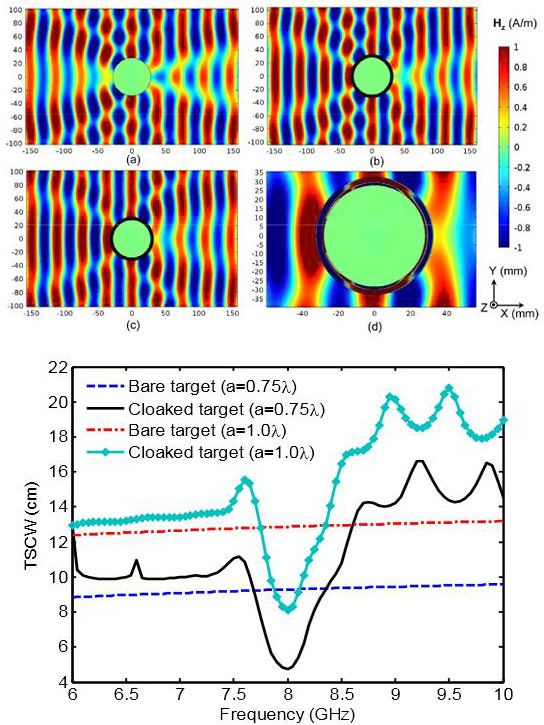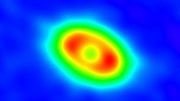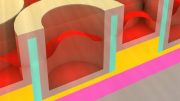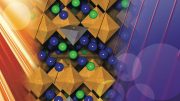
Top: Color online) Snap-shots of Hz distributions for fwork=8 GHz at TM wave incidence on: (a) bare metallic cylinder with the radius 0.75 λwork; (b) the same target cloaked by the shell with material parameters prescribed by Eq. (7); (c) the same target cloaked by the multi-layer dielectric shell; (d) zoomed-in view of (c).
Bottom: (Color online) The TSCW spectra obtained by integrating the simulated far-fields for the cloaked and bare targets of two different sizes. Dimensional parameters of the multi-layer dielectric cloaks in both cases were fixed for the wavelength corresponding to fwork=8 GHz. Credit: Michigan Technological University; Xiaohui Wang and Elena Semouchkina, DOI: 10.1063/1.4796171
Using a new kind of cloak that uses a very thin multilayer dielectric coating made of natural material, not metamaterial, researchers at Michigan Technological University demonstrated better cloaking efficiency than a similarly sized metamaterial cloak designed by using the transformation optics relations.
Michigan Technological University’s invisibility cloak researchers have done it again. They’ve moved the bar on one of the holy grails of physics: making objects invisible.
Just last month, Elena Semouchkina, an associate professor of electrical and computer engineering at Michigan Tech, and her graduate student, Xiaohui Wang, reported successful experimental demonstration of the use of non-conductive ceramic metamaterials to cloak cylindrical objects from microwave-length electromagnetic waves. Previously, Semouchkina had designed a non-conductive glass metamaterial cloak that worked with infrared frequency waves, which are shorter than microwaves.
Then, scarcely was the ink dry on their report in the IEEE Microwave and Wireless Components Letters, a journal published by the Institute of Electrical and Electronics Engineers, when they developed a different cloaking approach and published it in the American Institute of Physics journal, Applied Physics Letters.
This time, they used ordinary dielectric materials such as ceramics having differing dielectric permittivity—a measure of the response of a substance to an electrical field— instead of metamaterials, which are artificial materials with properties not found in nature. They found that they were able to cloak larger cylindrical objects and cloak them more effectively than they had using metamaterials.
This research, just published online and supported by the National Science Foundation (NSF), also won Wang an honorable mention in an IEEE student papers competition. Wang’s paper will be listed in the Technical Program Booklet at an upcoming IEEE International Symposium on Antennas and Propagation. He received $1000 IEEE grant to travel to the symposium to present this work.
According to their report in the Applied Physics Letters article, Semouchkina and Wang designed a new kind of cloak that uses a very thin multilayer dielectric coating made of natural material, not metamaterial. They compared it through mathematical analysis and computer simulations to a metamaterial cloak of similar size but based on a different principle, called transformation optics.
“The new cloak demonstrated better cloaking efficiency than did a similarly sized metamaterial cloak designed by using transformation optics relations,” said Semouchkina.
The new cloak outperforms previous cloaks, which caused more reflection and more shadows, as well as distortion of the electromagnetic waves, the researchers reported. It is eight to nine times thinner than metamaterial cloaks and much simpler to make, they noted.
“The multi-layer dielectric cloak could easily be scaled to work in a variety of frequency ranges,” Semouchkina said. “The design procedure developed in this work could be used to further advance the cloak parameters and for adjusting it to practical needs.”
Cloaking may sound like a magic trick or something out of a movie, but it could prove useful in national security, law enforcement or other applications.
Reference: “A route for efficient non-resonance cloaking by using multilayer dielectric coating” by Xiaohui Wang and Elena Semouchkina, 19 March 2013, Applied Physics Letters.
DOI: 10.1063/1.4796171









We haven’t even thought about the harrmful psychological affects this will have on mankind.
Sweet. Not I can discard my X-Ray specs!
Utterly irrelevant.
Such as..?
Effects. It’s EFFECTS.
OK but the REAL question is: When will this be available for my Romulan War Bird?
I can’t be the only one who does not want to see this level of technology in the hands of our current world governments, who are already outside of accountability for their actions, am I?
I also agree with Theresa’s concern. We already have a paranoia problem in human psychology, and this is only going to exacerbate this issue.
Until we can marshal together an ethical and wise form of human governance, technological advancements, such as these, only serve to further keep humanity for finding true liberty.
Governments? What about corporate Gods?
-The tech will most likely never reach a point where it is portable and at the same time perfectly invisible, at least not in quite a while.
-True liberty? Is this some sort of vital nutrient you americans need to survive? Do you even understand what it is you are saying or are you just spouting bs so it sounds important? Lets put some money into getting fusion reactors up and running or maybe even sustainable agriculture.
No need for a picture guys, you wouldn’t see it anyways..
So will surgeons use this to make their hands invisible so surgery is easier?
OrtyBortoty, that is a smart idea. And the only relevant comment I’ve seen on this. There would be a great number of applications like that: auto mechanics and computer techs could disappear their hands as well. You could use this on top of audio-visual equipment in a presentation so it would not obscure the view for anyone. How about making it a permanent fixture in concert halls– there would be no obstructed seating because you could put it around columns. Brilliant idea.
Yeah, but then you would have people running in to things all the time
“her graduate student, Xiaohui Wang”
Great, we will have cloaked chinese stealth planes on us from leaked information before this is even available over here.
Pfffft. Came here to see something invisible .
You did, That’s the whole point.
the microwave people can’t see me when im in my microwave cloak
“large objects” How large? Like a human, or like a human hair?
you know, i never thought about the implications of this kind of technology advancement until i read a few of these comments. i was just excited to hear of its existence. Perhaps we as a people are too paranoid for something like this. maybe their vision is too limited to its possibilities. maybe individuals need to stop labeling others as “you Americans” as if it were an insult. Just maybe….we’ll get those hover cars next?
CLOAK ENGAGED!
crysis gg
Perhaps this will enable our President to finally live up to his promise of a more TRANSPARENT administration…
this cloaking tech. is’nt it still visibal to the naked eye?
What about when terrorists get a hold of it, or a bank robber or house robber? Did anyone ever think of that? (and the Chinese Stealth planes as mentioned above). Scary thought !!!
OK so they figure out a way to cloak people and things in a product that only reflects invisible light. We can’t see those wavelengths so those things are invisible and there will be many uses for it. But one of the first industries such an invention creates is the market for optics that will detect those objects, just like the infra-red viewers of today and they will do it. Nothing to fear here,
This info really help people to know new things.
This is actually really cool stuff – Haha, they should make a video if it gets completed! I want one during family gatherings!